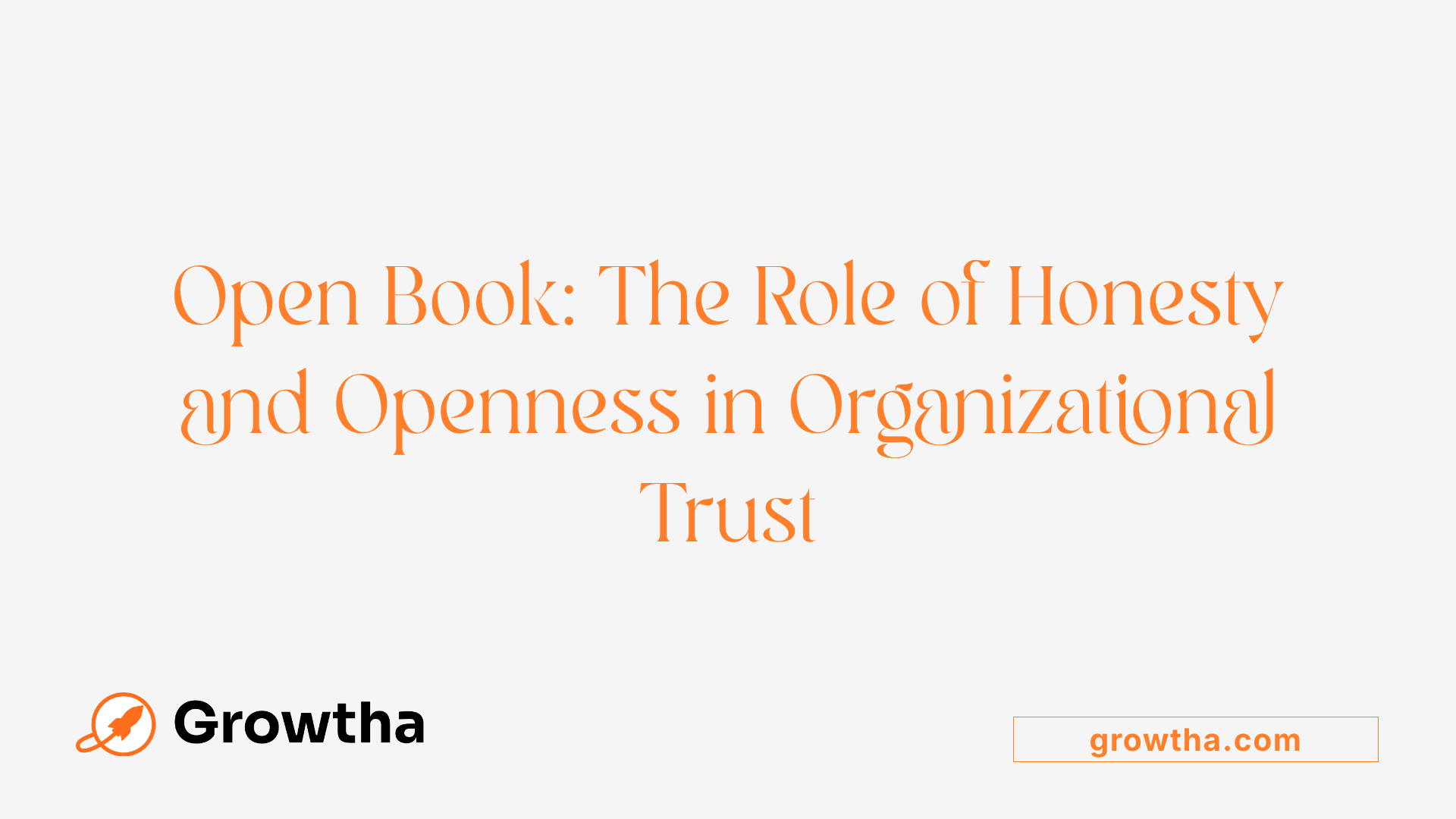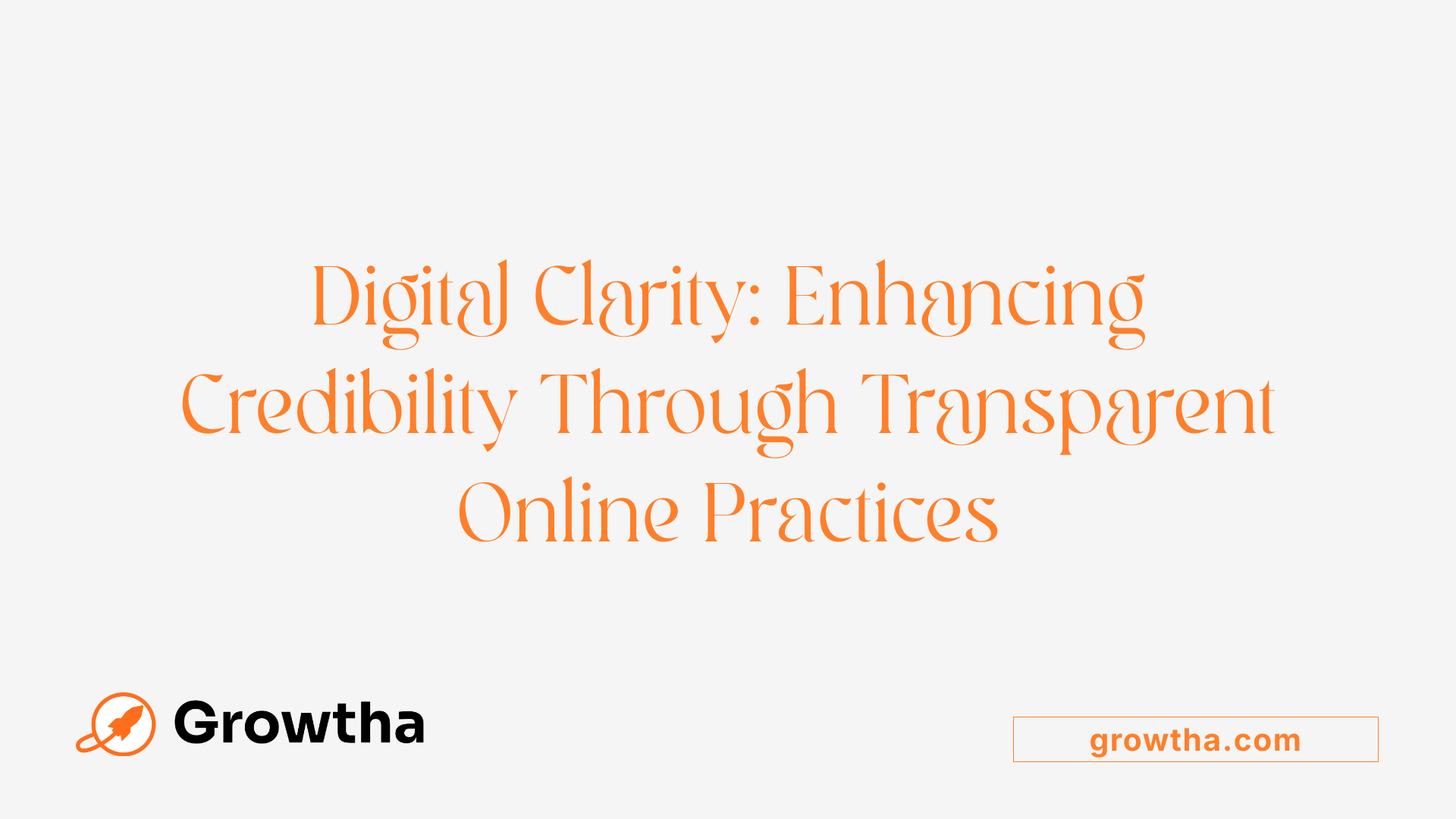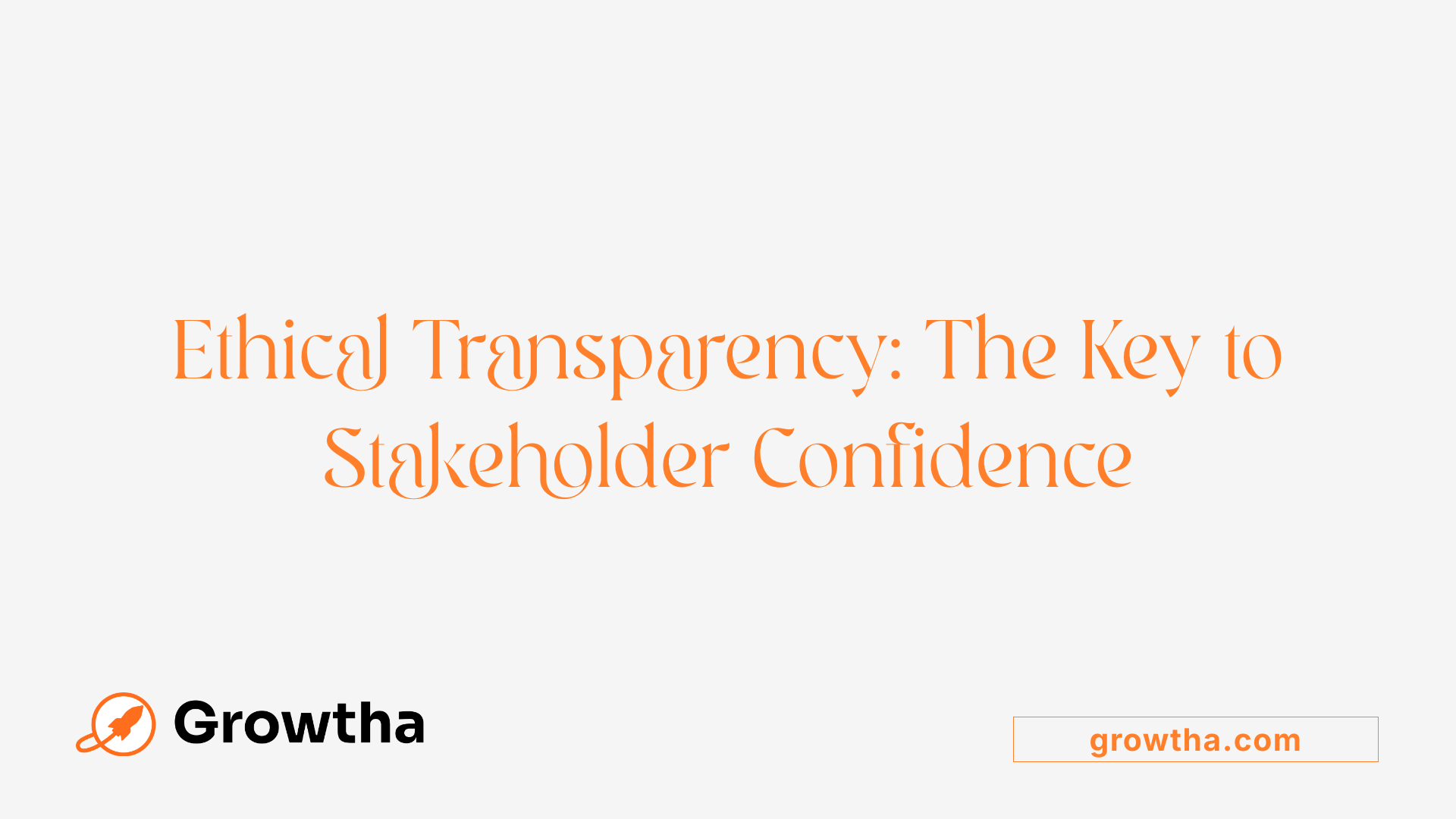Building Trust Through Transparent Online Communication
Enhancing Credibility in the Digital Age


Building Trust Through Transparent Online Communication
The Power of Transparency in Online Trust Building
In today's interconnected world, transparency has become a cornerstone of establishing and maintaining trust online. Organizations, brands, and leaders who embrace open, honest, and consistent communication significantly strengthen relationships with stakeholders. This article explores effective strategies and best practices for fostering trust through transparent online communication, illustrating their impact on organizational success and reputation.
Understanding the Foundations of Transparency and Trust

What is the concept of transparency in organizations?
Transparency in organizations refers to the practice of openly sharing information related to the company’s values, operational practices, financial performance, and decision-making processes. It involves providing clear, accessible, and timely communication to stakeholders. Effective transparency requires not only disclosing positive outcomes but also being honest about challenges and setbacks.
Organizations use various tools and frameworks to ensure transparency while safeguarding sensitive data. These include digital platforms like client portals, real-time updates, surveys, and open-door policies. Transparency is critical during crises, where honest updates can strengthen consumer trust, and in daily operations, to promote a culture of openness.
How does transparency demonstrate openness and honesty?
Demonstrating openness means sharing information without withholding details, even when the news isn’t favorable. Honesty entails providing truthful, straightforward responses and admitting mistakes. Leaders who embrace transparency actively communicate policies, decisions, and challenges transparently, thus fostering credibility.
For example, brands like Patagonia openly share their environmental impact, reinforcing their authenticity. Likewise, CEOs providing quarterly updates or sharing real-time project data exemplify transparency in action. This openness fosters a sense of fairness and accountability, encouraging stakeholders to engage more deeply.
What is the link between transparency and trust-building?
Transparency directly contributes to building trust by establishing a foundation of honesty and consistency. When organizations communicate openly and address concerns transparently, they create an environment where stakeholders feel valued and secure.
Research indicates that organizations with transparent communication are 45% more likely to retain top talent and 89% more likely to enjoy higher employee engagement. Similarly, in customer relationships, transparency increases satisfaction and loyalty; 75% of clients consider transparency a top factor in their satisfaction.
A vivid example is Skanska USA, which improved client satisfaction by 20% after providing real-time project updates. This approach underscores how transparency fosters credibility, reduces misunderstandings, and cultivates long-term trust.
How does transparency enhance organizational trust?
By consistently applying transparent practices—such as clear policies, honest reporting, and active listening—organizations can cultivate a culture of trust. This not only improves internal cohesion by fostering open dialogue among team members but also boosts external reputation.
In summary, transparency involves open sharing, honesty, and accountability. It plays a vital role in establishing trust, whether in leadership, customer relations, or corporate governance. As organizations embrace transparency, they pave the way for increased engagement, stronger relationships, and sustainable success.
For further insights, exploring the benefits of transparency in organizations reveals that it supports better decision-making, risk management, and stakeholder confidence—critical aspects for any thriving entity.
Digital Transparency and Its Strategic Significance

What is the importance of transparency in digital communication?
Transparency in digital communication plays an essential role in establishing trust and strengthening relationships with stakeholders, including customers, employees, and the public. When organizations openly share relevant information—such as data practices, company values, and operational updates—they demonstrate honesty and integrity.
During crises or sensitive situations, transparent communication helps prevent misinformation and builds credibility. For example, during the COVID-19 pandemic, Vistara Airlines was praised for openly acknowledging gaps and communicating honestly with customers, which earned public respect and contributed to recovery efforts.
In today’s digital landscape, brands that align their online actions with their core values and communicate authentically on social media and other platforms foster social trust. This openness encourages meaningful engagement, informed decision-making, and long-term loyalty.
Ultimately, digital transparency not only boosts credibility but also promotes accountability, fosters societal change, and supports strategic growth.
Open Communication and Cultural Cohesion

What role does open and transparent communication play in building and maintaining trust?
Open and transparent communication is fundamental to establishing a culture of trust within organizations. When companies actively share information about their decisions, challenges, and successes, they demonstrate honesty and accountability. This openness fosters respect among employees and stakeholders, encouraging a two-way dialogue.
By engaging in clear and honest conversations, organizations show they value transparency, which reassures teams and clients alike. This approach not only builds initial trust but also sustains it over time. When employees and stakeholders see that information is shared responsibly and responsively, they develop confidence in leadership and the organization.
Effective transparency involves ethical communication—being truthful and responsible in all interactions. Such practices reduce misunderstandings, prevent rumors, and create a safe environment for feedback. When issues or setbacks occur, openly addressing them instead of hiding facts helps reinforce the organization’s credibility.
Overall, consistent, empathetic, and truthful communication nurtures trust, supports stronger relationships, and helps organizations navigate both opportunities and crises successfully.
Building Stakeholder Confidence Through Ethical Practices

How can transparency in communication build trust with stakeholders?
Transparency in communication is essential for establishing and maintaining trust with stakeholders. When organizations openly share information about their values, operational practices, and financial health, stakeholders feel more confident in the company’s integrity. Honest, accurate, and timely updates about company performance and decision-making help prevent misunderstandings and suspicions, fostering a culture of openness.
Adhering to ethical standards—such as honesty, fairness, and confidentiality—not only aligns with legal obligations but also demonstrates a company's commitment to integrity. For example, openly discussing financial data, challenges, and successes reassures stakeholders that the company values transparency and accountability.
This approach encourages informed decision-making and creates a strong foundation for long-term relationships. When stakeholders perceive an organization as truthful and ethically responsible, their trust deepens, which enhances reputation and loyalty. Overall, consistent adherence to ethical communication practices strengthens stakeholder confidence and sustains a positive, mutually respectful relationship.
Crisis Management and Transparency’s Critical Role
How does transparency in communication build trust?
Transparency in communication is essential for cultivating genuine trust, especially during challenging times like crises or setbacks. It demonstrates openness and honesty, fostering an environment where stakeholders feel informed and valued.
During a crisis, transparent communication involves sharing accurate information promptly and admitting uncertainties without hiding facts. This openness helps reduce rumors and misinformation, which can cause unnecessary panic or confusion.
Handling setbacks and negative news openly is equally vital. Companies that acknowledge mistakes, explain what went wrong, and outline steps to address issues show they are accountable. This honest approach reassures stakeholders that the organization values integrity over concealment.
Rebuilding trust after missteps involves consistent, transparent actions that demonstrate commitment to improvement. Leaders who communicate openly about challenges and progress foster credibility and patience among their audience.
Research indicates that organizations practicing transparency in crisis situations are better able to maintain stakeholder confidence and loyalty. For example, during the COVID-19 pandemic, companies like Vistara openly shared their challenges and recovery strategies, which garnered respect and trust.
In summary, transparent communication during crises not only helps manage immediate concerns but also strengthens long-term relationships, emphasizing that honesty and openness are crucial for resilient, trust-based engagements.
Implementing Internal Transparency Through Leadership and Policies
How can transparency in communication build trust with stakeholders?
Transparency in communication plays a vital role in cultivating trust within organizations and with external stakeholders. When companies share honest, accurate, and timely information about their operations, values, and decisions, they demonstrate integrity and foster confidence.
This openness helps prevent misunderstandings and suspicion, creating an environment where stakeholders feel valued and respected. Adhering to ethical principles such as honesty and fairness not only promotes accountability but also aligns with legal compliance, reinforcing the organization's credibility.
Building a culture of transparency involves consistent and clear reporting, openly discussing challenges and setbacks, and sharing successes with stakeholders. Such practices show a commitment to integrity and foster a long-term trust that sustains relationships.
Role of leadership and policy in transparency
Leadership sets the tone for transparency within an organization. Leaders who champion openness encourage honest dialogue and model transparent behaviors, which permeate all levels of the company.
Well-defined policies are essential components that formalize commitment to transparency. These policies outline expectations, standards, and procedures for sharing information, managing disclosures, and protecting sensitive data.
Creating clear guidelines ensures that all employees understand their roles in maintaining transparency and accountability. This structured approach helps prevent miscommunication and provides a framework for ethical decision-making.
Creating an environment of openness and accountability
Fostering an environment where open communication flourishes requires establishing safe channels for dialogue. Regular updates, town halls, and feedback mechanisms such as surveys promote inclusiveness and participation.
Accountability is reinforced when organizations openly acknowledge mistakes and take corrective actions. Transparency in reporting setbacks or errors demonstrates honesty and builds credibility.
Encouraging a culture that values transparency involves recognizing and rewarding openness, as well as providing training on ethical communication practices.
Training and empowering employees in transparent practices
Empowering employees through training helps embed transparency into everyday operations. Training sessions should focus on effective and ethical communication, data handling, and reporting practices.
Employees need to understand the importance of transparency and how to implement it in their roles. Providing tools and resources, such as communication guidelines and digital platforms, supports this effort.
Leadership must also promote an environment where employees feel safe to share concerns and speak openly without fear of reprisal. This proactive approach ensures transparency becomes embedded in the organizational culture, strengthening relationships internally and externally.
Conclusion: Cultivating a Culture of Transparency
What are the long-term benefits of transparency?
Embracing transparency within organizations yields numerous enduring advantages. Over time, it fosters stronger trust among employees, clients, and stakeholders. Companies that prioritize openness tend to enjoy increased loyalty, higher engagement levels, and improved brand reputation. Employee morale benefits significantly, with transparent environments encouraging collaboration and innovation. This openness also enhances risk management by enabling early identification and mitigation of issues, reducing the likelihood of crises.
Moreover, transparency supports sustainable growth by building a resilient organizational culture that values honesty and accountability. Such cultures attract and retain top talent, as 81% of clients are more likely to continue working with transparent companies. Over the long term, this creates a stable foundation for success, driven by mutual trust and respect.
Is building trust an ongoing process?
Absolutely. Trust is not a one-time achievement but a continual effort that requires consistent attention and genuine commitment. Implementing transparent communication practices, such as regular updates, honest feedback, and open dialogue, is essential. Leaders must model transparency through their actions, sharing both successes and setbacks openly.
Organizations should view trust-building as a journey that involves listening, responding, and adapting over time. For example, transparent leaders who proactively share information about company challenges or project setbacks demonstrate authenticity, which sustains credibility.
Regular engagement through town halls, surveys, and real-time updates help maintain and deepen trust. A study shows that 89% of companies with transparent communication practices report higher employee engagement, emphasizing trust's role in organizational vitality.
What strategies can embed transparency in organizational culture?
Embedding transparency requires deliberate strategies that become part of the company’s core values. Some effective approaches include:
- Formal Policies and Frameworks: Establishing clear guidelines on information sharing, data privacy, and communication channels.
- Leadership Modeling: Senior leaders practicing openness and approachable behaviors set a tone that permeates the organization.
- Regular Communication: Hosting virtual town halls, distributing newsletters, and maintaining accessible intranet portals create continuous information flow.
- Feedback Mechanisms: Using surveys, polls, and open-door policies to solicit input and foster two-way communication.
- Training and Education: Equipping employees with skills to communicate transparently and handle difficult conversations.
- Utilizing Technology: Implementing tools like client portals, project management software, and real-time dashboards enhances transparency, especially during complex projects.
Case studies highlight that organizations like Skanska USA improved client satisfaction scores by 20% by providing real-time project updates. Their success underscores transparency’s strategic value in decision-making and relationship management.
An integrated approach that combines these strategies creates a culture where transparency is ingrained, leading to sustained trust and organizational resilience.
| Aspect | Implementation Strategies | Benefits |
|---|---|---|
| Leadership | Model open behaviors, share decisions openly | Builds credibility and sets cultural tone |
| Communication Channels | Town halls, newsletters, intranet, surveys | Ensures consistent and accessible information |
| Technology Usage | Real-time updates, project management tools, dashboards | Enhances clarity especially for remote or complex projects |
| Training and Education | Develop communication skills and transparency awareness | Fosters openness and accountability |
| Feedback Mechanisms | Regular surveys, open forums, response protocols | Creates a culture receptive to improvement |
Building a transparent organization is an ongoing endeavor. When embedded deeply into the culture, it naturally enhances trust, partnership, and shared success across all levels.
Embracing Transparency for Enduring Trust
Building trust through transparent online communication is a continuous process that requires deliberate effort, authentic engagement, and a commitment to ethical standards. By adopting best practices, leveraging technology, and fostering an open organizational culture, organizations can establish credible relationships that stand the test of time. Transparency is more than just an ethical obligation—it is a strategic asset that enhances reputation, cultivates loyalty, and facilitates long-term success. Cultivating a culture of transparency ensures that trust remains at the core of every interaction, underpinning sustainable growth and organizational resilience.
References
- Building Trust Through Transparent Communication - Highly.Digital
- Building Trust Through Transparent Communication
- Building trust in brand marketing with transparent and authentic PR ...
- How Can Construction Firms Build Client Trust Through Transparent ...
- Building Public Trust through Transparent Internal Communications
- Building Trust Through Transparent Communication: The PR ...
- Building Consumer Trust through Transparent Trust and Safety ...
- Building Trust Through Transparency: The Foundation of Strong ...
- Building Trust Through Transparent Succession Conversations
- (PDF) Building Consumer Trust Through Transparent Digital ...







